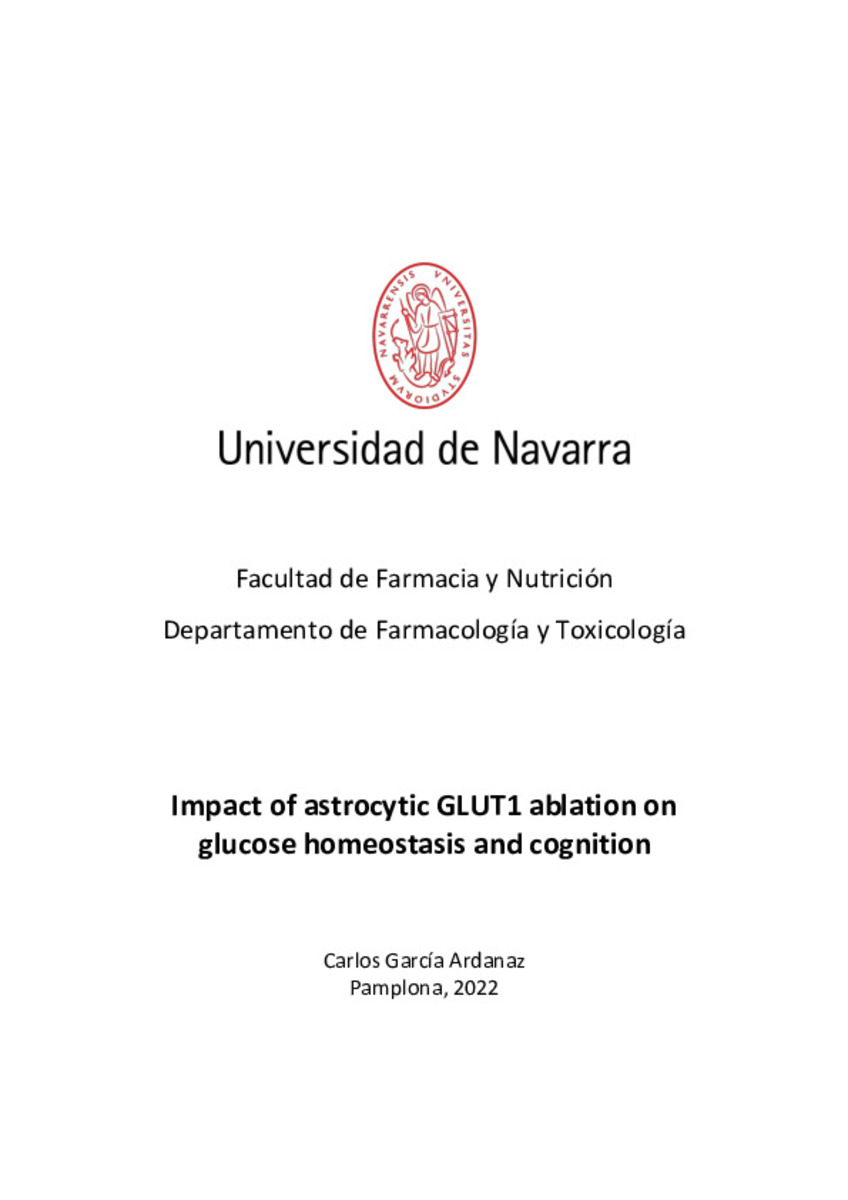Full metadata record
| DC Field | Value | Language |
|---|---|---|
| dc.contributor.advisor | Solas, M. (Maite) | - |
| dc.contributor.advisor | Ramirez, M.J. (María Javier) | - |
| dc.creator | García-Ardanaz, C. (Carlos) | - |
| dc.date.accessioned | 2023-01-24T08:59:54Z | - |
| dc.date.available | 2023-01-24T08:59:54Z | - |
| dc.date.issued | 2022-01-24 | - |
| dc.date.submitted | 2022-12-16 | - |
| dc.identifier.citation | GARCÍA, Carlos. "Impact of astrocytic GLUT1 ablation on glucose homeostasis and cognition". Solas, M. y Ramírez, M.J. (dirs.). Tesis doctoral. Universidad de Navarra, Pamplona, 2022. | es_ES |
| dc.identifier.uri | https://hdl.handle.net/10171/65104 | - |
| dc.description.abstract | Glucose transporter 1 (GLUT1) is the main transporter mediating glucose access from the blood to the brain. In fact, homozygous ablation of GLUT1 selectively in brain vascular endothelial cells is ultimately incompatible with life, and its heterozygous ablation in these cells prompts a severe breakdown of both brain glucose metabolism and cognitive abilities. Astrocytes keep an intimate connection with both brain blood vessels and synaptic terminals, and are considered an essential source of blood-borne glucose or its metabolites to neurons. Nonetheless, the necessity of the main astrocyte glucose transporter, i.e. GLUT1, for brain glucose metabolism has not been defined. Unexpectedly, we found that brain glucose utilization was paradoxically augmented in mice featuring astrocyte-specific GLUT1 ablation (GLUT1GFAP mice). These mice also exhibited improved systemic glucose metabolism with increased glucose tolerance and glucose-stimulated insulin secretion, as well as upgraded brown adipose tissue activity. Obese GLUT1GFAP animals especially benefited from these phenotypic features, which resulted in rendering them metabolically healthier than obese control animals. Noteworthy, GLUT1GFAP mice did not present alterations regarding spatial memory performance, and even slightly outperformed control mice regarding recognition memory capacities. Mechanistically, we observed that GLUT1-ablated astrocytes exhibited increased insulin receptor-dependent ATP release, and that both astrocyte-specific insulin signaling and brain purinergic signaling are essential for the improved systemic glucose homeostasis and cognitive maintenance shown by GLUT1GFAP mice. Furthermore, it is known that Alzheimer s disease (AD) patients feature decreased GLUT1 levels, and that GLUT1 ablation in brain vascular endothelial cells accelerates the progression of an AD-like pathology in an AD mouse model. Moved by the above-mentioned findings, we induced astrocyte-specific GLUT1 ablation in the AD mouse model APP/PS1 (APP/PS1-GLUT1GFAP mice). Strikingly, we found that APP/PS1-GLUT1GFAP mice showed a decreased mortality rate, as well as markedly improved cognitive performance, in comparison to APP/PS1 mice. Importantly, chemogenetic perturbation of astrocytic Ca2+ activity totally abrogated the cognitive improvement elicited by astrocytic GLUT1 ablation. Collectively, we demonstrate that astrocytic GLUT1 is central to the regulation of brain energetics, yet its ablation triggers a reprogramming of brain metabolism sufficient to sustain brain energy requirements, systemic glucose homeostasis and cognitive function. | es_ES |
| dc.language.iso | eng | es_ES |
| dc.publisher | Universidad de Navarra | es_ES |
| dc.rights | info:eu-repo/semantics/openAccess | * |
| dc.subject | Materias Investigacion::Farmacia::Farmacia y farmacología | es_ES |
| dc.subject | GLUT1 | es_ES |
| dc.subject | Astrocytic GLUT1 ablation | es_ES |
| dc.subject | Glucose homeostasis | es_ES |
| dc.subject | Cognition | es_ES |
| dc.subject | Brain | es_ES |
| dc.subject | Energy substrates | es_ES |
| dc.subject | Astrocytes | es_ES |
| dc.subject | Genetic mouse models | es_ES |
| dc.title | Impact of astrocytic GLUT1 ablation on glucose homeostasis and cognition | es_ES |
| dc.type | info:eu-repo/semantics/doctoralThesis | es_ES |
| dc.identifier.doi | 10.15581/10171/65104 | - |
Files in This Item:
Statistics and impact
Items in Dadun are protected by copyright, with all rights reserved, unless otherwise indicated.






